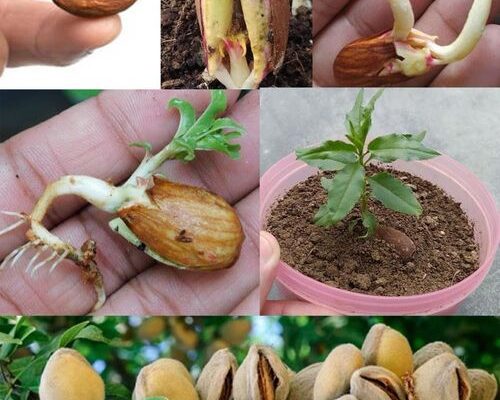Introduction:
Almonds, a beloved snack and versatile ingredient, can also be grown at home with relative ease. In this comprehensive guide, we’ll explore the step-by-step process of successfully cultivating almond trees from seeds. Whether you’re a gardening enthusiast or simply curious about the journey from seed to tree, this guide will provide you with valuable insights.
1. Selecting Seeds:
Contrary to popular belief, you don’t need specialized almond seeds to start your own almond tree. Simply purchase raw almonds from your local supermarket. These almonds contain viable seeds within their shells, ready to sprout and grow into trees.
2. Seed Preparation:
Before planting, it’s essential to prepare the seeds properly. Crack open the almond shells to reveal the seeds inside. Be cautious not to damage the seeds during this process. Once opened, carefully remove the almond seeds.
3. Choosing the Planting Method:
There are various methods for planting almond seeds, but we’ll focus on the most straightforward approach. You can either plant the seeds directly in soil or germinate them indoors using a moist paper towel. Both methods can yield successful results, but planting directly in soil is often preferred.
4. Soil Preparation:
Prepare a suitable potting mix for planting your almond seeds. A mixture of peat moss, perlite, and sand works well. Ensure the soil is well-draining to prevent waterlogging, which can hinder seed germination.
5. Planting Almond Seeds:
Plant the almond seeds in the prepared soil at a depth of approximately one centimeter. Space the seeds evenly within the planting container to allow for proper root development.
6. Germination and Growth:
Place the planted seeds in a warm, sunny location and keep the soil consistently moist. Almond seeds typically germinate within two to three weeks under optimal conditions. As the seeds sprout, small seedlings will emerge, signifying the beginning of growth.
7. Caring for Almond Seedlings:
Once the seedlings have emerged, continue to provide adequate sunlight and water. Almond trees thrive in well-draining soil and full sunlight. Regularly monitor the soil moisture to ensure it remains consistently damp but not waterlogged.
8. Transplanting Seedlings:
As the almond seedlings grow, they will eventually outgrow their initial containers. Transplant them into larger pots or directly into the ground, spacing them at least 15 centimeters apart. Ensure the planting location receives ample sunlight and has well-draining soil.
9. Maintenance and Pruning:
To encourage healthy growth and fruit production, prune the almond trees as needed. Remove any dead or damaged branches and shape the tree to promote optimal branching structure. Additionally, provide occasional fertilization during the growing season to support vigorous growth.
10. Harvesting Almonds:
With proper care and patience, your almond trees will begin to bear fruit within two to three years. Harvest the almonds when the hulls split open, revealing the mature nuts inside. Allow the almonds to dry thoroughly before storing them in a cool, dry place.
Conclusion:
Growing almonds from seeds is a rewarding and enjoyable endeavor that offers both aesthetic beauty and delicious rewards. By following these steps and providing proper care, you can successfully cultivate almond trees in your own backyard. Embrace the journey from seed to tree and enjoy the fruits of your labor for years to come.



